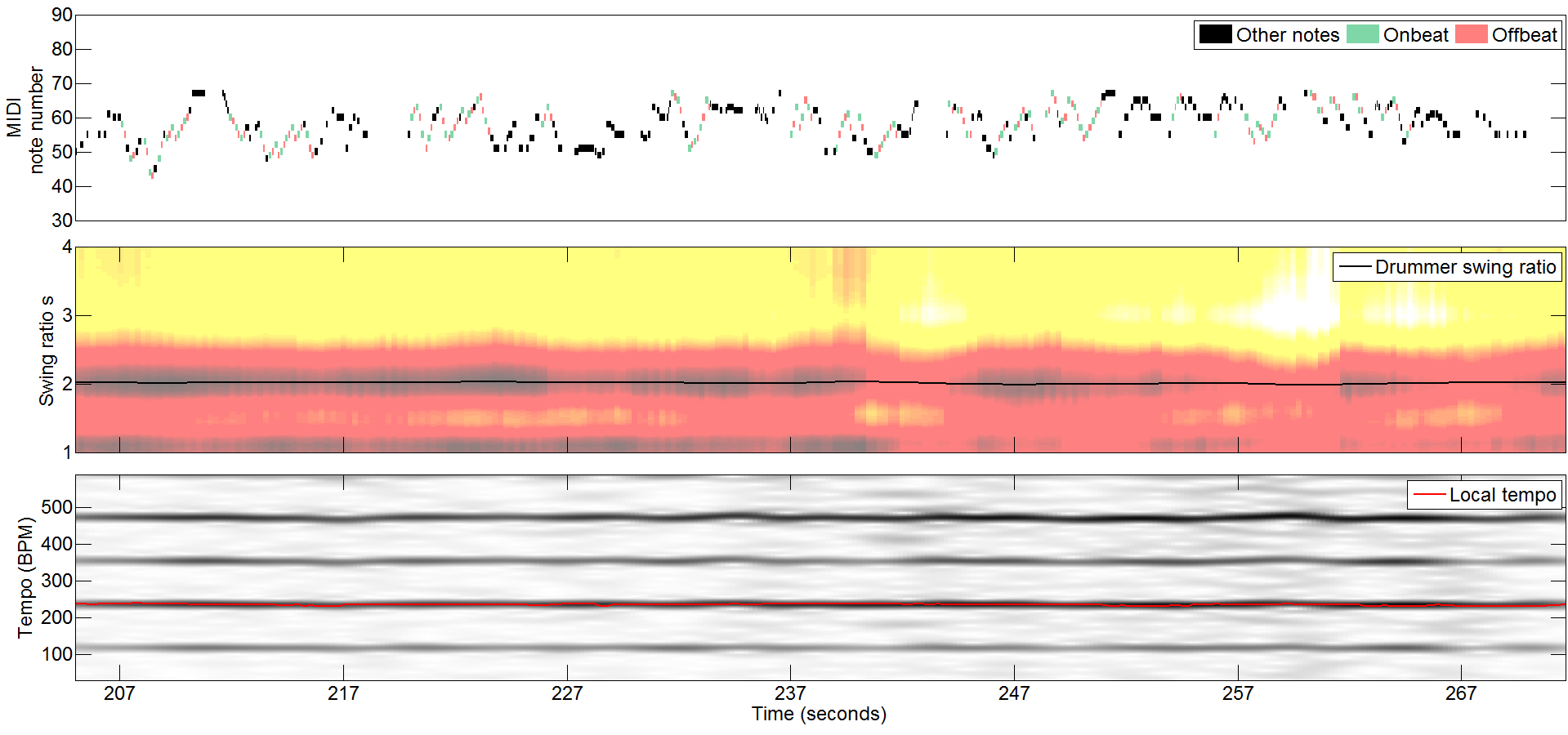A Swingogram Representation for Tracking Microrhythmic Variations in Jazz Performances
| [Back to Main Page] |

Discussion
In the figures above, we show the piano-roll, swingogram, and tempogram of a solo section from the 1960 recording of "The Red Door". This excerpt features solo baritone sax player Gerry Mulligan and drummer Mel Lewis. It is remarkable that Lewis keeps the idealized tied triplet swing ratio for more than 60 seconds at an average tempo around 236 BPM. Mulligan plays in the same clockwork-like fashion, almost always synchronizing his onbeat onsets to those of Lewis. However, he shows quite some variability in his offbeat onsets, showing higher swing ratio at phrase endings, as hypothesized by Benadon [4].
Legal notice
The video linked on this page are given for educational purposes only. If any legal problems occur, please contact us. Any content that allegedly infringes the copyright of a third party will be removed upon request by the copyright holder.
References
- Christian Dittmar, Martin Pfleiderer, and Meinard Müller
Automated Estimation of Ride Cymbal Swing Ratios in Jazz Recordings
In Proceedings of the International Conference on Music Information Retrieval (ISMIR): 271–277, 2015. PDF@inproceedings{DittmarPM15_Swing_ISMIR, author = {Christian Dittmar and Martin Pfleiderer and Meinard M{\"u}ller}, title = {Automated Estimation of Ride Cymbal Swing Ratios in Jazz Recordings}, booktitle = {Proceedings of the International Conference on Music Information Retrieval ({ISMIR})}, address = {M\'{a}laga, Spain}, year = {2015}, pages = {271--277}, url-pdf = {http://ismir2015.uma.es/articles/143_Paper.pdf} } - Peter Grosche and Meinard Müller
Extracting Predominant Local Pulse Information from Music Recordings
IEEE Transactions on Audio, Speech, and Language Processing, 19(6): 1688–1701, 2011. Details DOI@article{GroscheM11_PLP_TASLP, author = {Peter Grosche and Meinard M{\"u}ller}, journal = {IEEE Transactions on Audio, Speech, and Language Processing}, title = {Extracting Predominant Local Pulse Information from Music Recordings}, number = {6}, publisher = {IEEE}, volume = {19}, year = {2011}, pages = {1688--1701}, doi = {10.1109/TASL.2010.2096216}, url-details = {https://www.audiolabs-erlangen.de/resources/MIR/tempogramtoolbox} } - Matthias Gruhne and Christian Dittmar
Improving Rhythmic Pattern Features Based on Logarithmic Preprocessing
In Proceedings of the Audio Engineering Society (AES) Convention, 2009. PDF@inproceedings{GruhneD09_LogLagACF_AES, author = {Matthias Gruhne and Christian Dittmar}, title = {Improving Rhythmic Pattern Features Based on Logarithmic Preprocessing}, booktitle = {Proceedings of the Audio Engineering Society ({AES}) Convention}, address = {Munich, Germany}, year = {2009}, url-pdf = {http://www.aes.org/e-lib/browse.cfm?elib=15013}, } - Fernando Benadon
Slicing the beat: Jazz eighth-notes as expressive microrhythm
Ethnomusicology: 73–98, 2006. PDF@article{Benadon06_SwingRatio_EM, title = {Slicing the beat: Jazz eighth-notes as expressive microrhythm}, author = {Fernando Benadon}, journal = {Ethnomusicology}, pages = {73--98}, year = {2006}, publisher = {JSTOR}, url-pdf = {https://www.jstor.org/stable/pdf/20174424.pdf}, } - Anders Friberg and Andreas Sundström
Swing Ratios and Ensemble Timing in Jazz Performance: Evidence for a common Rhythmic Pattern
Music Perception, 19(3): 333–349, 2002. PDF@article{FribergS02_SwingRatio_MP, title = {Swing Ratios and Ensemble Timing in Jazz Performance: Evidence for a common Rhythmic Pattern}, author = {Anders Friberg and Andreas Sundstr{\"o}m}, journal = {Music Perception}, volume = {19}, number = {3}, pages = {333--349}, year = {2002}, publisher = {JSTOR} url-pdf = {https://www.jstor.org/stable/pdf/10.1525/mp.2002.19.3.333.pdf}, }

